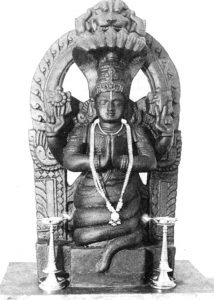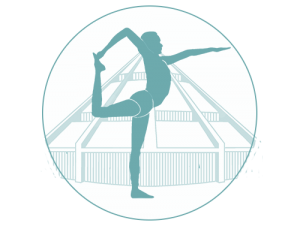“We train the body to make it a fit instrument to reach the highest goal, to contemplate Being.” ~ B.K.S. Iyengar

Traditional Statue of Patanjali · Creative Commons
Iyengar Yoga is based on the philosophy of the Yoga Sutras of Patanjali, an ancient text detailing the aim of the yogic path to quiet the mind so it can be filled with lucid awareness. The Yoga Sutras contain 196 sutras – short “threads” or poetic statements whose meaning is to be unpacked – and four chapters: Meditative Absorption, Practice, Mystic Powers and Absolute Independence.
Written more than 2,500 years ago, the Yoga Sutras is both a practical and inspiring work on the subject of Asthanga Yoga, the eight-limbed path towards spiritual fulfillment. The eight constituents of Patanjali’s yoga are:
- yama – moral conduct, self-restraint for living in society (non-violence, truthful, non-stealing, regulation of energies, absence of greed),
- niyama – self-discipline (purity, contentment, religious zeal, self-study, surrender of self to supreme Self or God),
- asana – physical postures,
- pranayama – control of the breath,
- pratyahara – internalization of the senses towards their source,
- dharana – concentration,
- dhyana – meditation,
- samadhi – absorption of consciousness in the self.
“All the eight steps are interpenetrating and interdependent,” writes Geetha Iyengar. In her noteworthy book, Gem for Women, she translates Patanjali’s sutra II.28 as “The study of the eight limbs of Yoga leads to the purification of the body, the mind, and intellect; the flame of knowledge is kept burning and discrimination is aroused.”
Practice and detachment – more specifically, repeated, steadfast practice done with goodness, purity, and freedom from attachment to outcomes – are the means to still the movement of the consciousness. B.K.S. refers to practice and detachment as “twin uprights of a ladder”; Geetha Iyengar likens them to two wings of an eagle.
Yoga is the concentrating all of the powers of the individual to the divine. As we practice the eight limbs of yoga, we are disciplining and aligning our particular powers of body, mind, emotions, intellect, and senses to see the Divinity within.
In the west, what is commonly referred to as “yoga,” is actually asana – the physical aspect of the practice of yoga. The third of eight constituents, what is the role of asana on the yogic path to Self- Realization?
In Light on Life, B.K.S. Iyengar asks how should we “practice asana in a way that leads to health and purity? In a way that leads from flexibility on to divinity?” He answers with Patanjali’s sutra II.46 Sthira sukham asanam, Patanjali’s basic definition of asana which he translates as “perfect firmness of body, steadiness of intelligence, and benevolence of spirit.” “For me,” Iyengar later wrote, “sthiram stands for satyam (truth), sivam (goodness), sukham (contentment), and asana (position) for sundaram (beauty).”
As each individual is electrically alive and dynamic, so yoga is a living dynamic force in life. ~ B.K.S. Iyengar
Iyengar Yoga focuses primarily on asana and pranayama as a comprehensive method for practicing all 8 limbs of yoga from purity to absorption. As students of Iyengar Yoga, we learn to focus our minds and bodies on the details of correct alignment and dynamic actions, and hold postures longer to observe and change what is unconscious or getting in the way. Abhijata Iyengar, Iyengar’s grand-daughter and now the senior teacher of Iyengar Yoga, explains that it’s Guruji’s contribution of working from the concrete to address the abstract that makes Iyengar Yoga so potent. She says, “In our practice, we need to trace what’s holding us back . . . because that part stops the flow of energy. Once that is addressed, the flow of energy is available for you to do what you want to do.”
The asana is not a position, it is a situation. ~ Abhijata Iyengar
Iyengar translates sutra II.47 Prayatna saithilya snanta samapattibhyam as: Perfection in an asana is achieved when the effort to perform it becomes effortless and the infinite being within is reached. That is, in Iyengar’s words, “perfect precision filled with divinity.”
That inspires my practice. I hope it will inspire yours, too.


